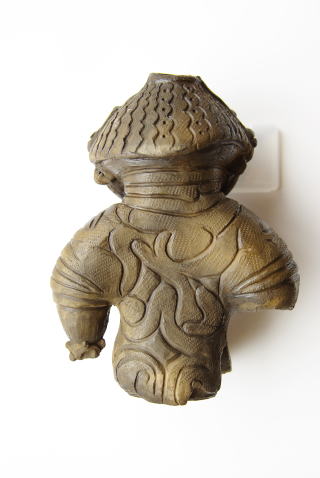(実寸)
¥50,000
巾15cm×丈20cm×厚さ11cm
■商品コード T-02903■
(箱別売り)
桐箱
・印籠型
¥10,000
▶注文(メール)
¥50,000
w15 cm x 20 cm long x 11 cm thick
Product Code T-02903
(Box sold separately)
paulownia box
Inroku style
¥10,000
▶email order


- この板柳出土土偶は、非常に精工に作られています。
- 愛称は「シャコボー」です。
事務所などの身近に置かれると良いと思います。
板柳土偶は、自分や周りを浄化、癒してくれると言います。
- This Kamegaoka Shading Device Dogu is very elaborately made.
His nickname is "Shakobo". - It is good to put it near your office.
Itayanagi Dogu says that it purifies and heals you and your surroundings.
- 価格は、「本体価格」表記です。別途、消費税が加算されます。
- 長年にわたり、制作活動を中止しておりましたが、この度再開できることになりました。
在庫のない場合でも2か月程でお届けできる予定です。
過去の土偶についてもお問合せください。 - Prices are listed in "Unit Price". A separate sales tax will be added to the price.
- I have stopped working on this project for many years, but I am now ready to start again.
We will be able to deliver it in about two months even if we don't have it in stock.
Please inquire about past Dogu artworks.
- 現在までに出土している土偶は大半が何らかの形で破損しており、故意に壊したと思われるものも多い。特に、脚部の一方のみを故意に破壊した例が多い。そのため、祭祀などの際に破壊し、災厄などを祓うことを目的に作成されたという説がある。
また、大半の土偶は人体を大きくデフォルメして表し、特に女性の生殖機能を強調していることから、安産・多産などを祈る意味合いがあったものと推定する説もある。
- その他、用途に関しては、生命の再生、神像(女神像を含む)、精霊の像、呪物、お守り(護符)など様々な説がある。子供の玩具やお守りであったとする説、破壊することで身体の悪い所の快癒を祈ったとする説、ばらばらになるまで粉砕された土偶はそれを大地にばら撤くことが豊穣の祈念を意味したとする説などもある。
また、集落のゴミ捨て場などに投棄された状態で出土されることが非常に多く、これは、最初から意図的に破壊して投棄することが目的であったという説を支持するものである。
ほかにも、考古学者・水野正好の唱える説では、縄文人は冬期の太陽の弱まりを怖れ、土偶祭祀は冬を中心に行われたという。
- 土偶(最狭義)は、人または人型の霊的存在を、こねた土で造形表現し、素焼きで焼成している。
全体的には人体を模して成形されているが、頭・胴・手・足などでは抽象的表現が非常に目立つ。
しかし、乳房、正中線(せいちゅうせん)、妊娠時の腹部、女性器、臀部など、特定の部位および状態の表現は具体的なものが多い。
- Most of the clay figurines that have been excavated to date have been damaged
in some way, and are thought to have been broken on purpose. There are
also many cases. In particular, there are many cases where only one of
the legs was intentionally destroyed. Some say that they were destroyed
during rituals to exorcise misfortune.
Most clay figurines are deformed to look like the human body and emphasize the reproductive functions of women in particular, so they are presumed to have been used to pray for safe births and high fertility.
- Other uses include regeneration of life, statues of gods (including goddesses), images of spirits, curses, amulets (protection), and ) and many other theories. The theory that they were children's toys or amulets, the theory that they were destroyed to pray for the healing of a bad part of the body, the theory that they were The clay figurines were smashed to pieces and scattered to the ground as a prayer for a good harvest. Some theories include.
These clay figures were very often found dumped at village garbage dumps, supporting the theory that the purpose of the clay figures was to destroy them from the start.
Another theory advanced by the archaeologist Mizuno Masayoshi is that the Jomon feared the weakening of the sun during the winter months, and that the rituals of Dogu were conducted mainly in winter.
-
Dogu (in the narrowest sense) is a form of human or human-shaped spiritual entity, which is shaped and represented with kneaded clay and fired without firing.
Overall, they are shaped to resemble the human body, but abstract expressions are very noticeable on the head, body, hands and feet.
However, there are many concrete expressions of specific areas and conditions, such as the breasts, midline, pregnant abdomen, female genitalia and buttocks.